

Crop irrigation in Mesopotamia may have spread disease. The Euphrates.

Image: Bertramz (Wikimedia Commons, used under a CC BY-SA 3.0) Secular to Sacred: The Story of the Lacock Cup. The Lacock Cup, plain and gilded silver, England, 15th century © 2014 The Trustees of the British Museum The Salisbury Museum in Wiltshire (south England), announces a new temporary exhibition, “Secular to Sacred: The Story of the Lacock Cup”, to run from 31st January until Monday 4th May 2015.
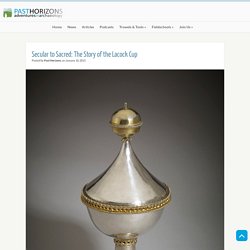
Made in the fifteenth century, the Lacock Cup is a breathtakingly rare masterwork by an unknown silversmith. A solid silver vessel of timeless simplicity, it has a unique history, having been used both as a feasting cup and a holy chalice. Its survival against all odds makes it a poignant English icon of endurance and tenacity. Pilgrim Badge portraying Our Lady of Tombelaine, pewter, early 15th century © The Salisbury Museum. Study of ancient dogs in the Americas suggests migration 10,000 years ago. A ritual burial of two dogs at a site in Illinois near St.
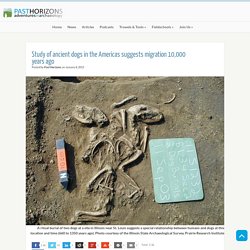
Louis suggests a special relationship between humans and dogs at this location and time (660 to 1350 years ago). Hellenistic period agora investigated at Nea Paphos. Ceramics retrieved from the well at Nea Paphos.
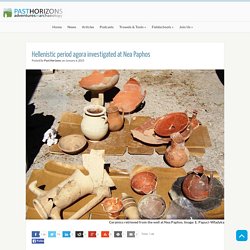
Image: E. Fabrika Hill: Excavating a Hellenistic-Roman Theatre. By Craig Barker In 331BC, while Alexander the Great rested his troops at Tyre (present-day Lebanon) before they campaigned further east, he organised a drama festival for the soldiers where leading actors from throughout the Greek world were brought to perform.

Old Sarum survey reveals new information about medieval city layout. Aerial view of Old Sarum.
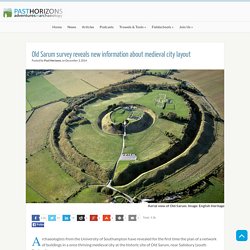
Image: English Heritage Archaeologists from the University of Southampton have revealed for the first time the plan of a network of buildings in a once thriving medieval city at the historic site of Old Sarum, near Salisbury (south England). A research team of students and academics carried out a geophysical survey of the ancient monument, scanning ground at the site with state-of-the-art equipment to map the remains of buried structures. They concentrated their survey around the inner and outer baileys of what was once a fortification, with its origins in the Iron Age and the Roman conquest. Students surveying Old Sarum. Features. Mesolithic sanctuary reveals constellation riddle. The earliest known depiction of a Siberian shaman, produced by the Dutch explorer Nicolaes Witsen.
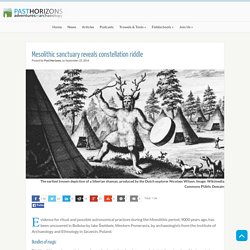
Image: Wikimedia Commons PUblic Domain Evidence for ritual and possible astronomical practices during the Mesolithic period, 9000 years ago, has been uncovered in Bolków by lake Świdwie, Western Pomerania, by archaeologists from the Institute of Archaeology and Ethnology in Szczecin, Poland. Roman fort discovered in Gernsheim. Roman brick fragment.

Image: Goethe-Universität Frankfurt am Main Archaeologists from Frankfurt University have discovered a long lost Roman fort at Gernsheim in Hesse (Germany). A troop unit made up out of approximately 500 soldiers (cohort) was stationed there between 70/80 and 110/120 AD. Acidic soil may give misleading view of Greek Dark Age village. Monumental Bronze Age tomb at Nichoria from above.
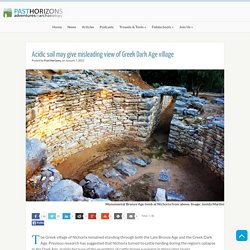
Image: Jonida Martini. Apolline Project: new discoveries on the dark side of Vesuvius. On the verge of completing her BA in Archaeology & Anthropology at Bristol University, and her sights set on an MPhil, Leah is preparing to launch herself into the thrilling world of archaeological research and journalism.
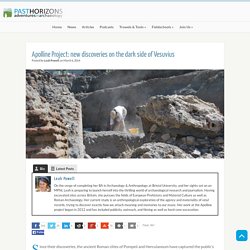
Having excavated sites across Britain, she pursues the fields of European Prehistory and Material Culture as well as Roman Archaeology. Her current study is an anthropological exploration of the agency and materiality of vinyl records, trying to discover exactly how we attach meaning and memories to our music. Her work at the Apolline project began in 2012 and has included publicity, outreach, and filming as well as hard-core excavation.
Documents from Roman Egypt give clues about childhood. Papyrus from Oxyrhynchos. Image: Public Domain In Roman Egypt, 14-year-old boys were enrolled in a youth organization in order to learn good citizenship, says social historian Ville Vuolanto, University of Oslo. Research supports Neanderthals as a separate species. Homo neanderthalensis Skull discovered in 1908 at La Chapelle-aux-Saints, France. Image: Luna04/Wikipedia (CC BY 2.5) In an extensive, multi-institution study led by SUNY Downstate Medical Centre, researchers have identified new evidence supporting the growing belief that Neanderthals were a separate species, and not a subspecies of modern humans.
The research looked closely at the entire nasal complex of Neanderthals, which appears not to be adaptively inferior to that of modern humans. This means that the Neanderthal nose would have been able to cope process with a colder and drier climate. Tracing changes in Nile Valley ecology over 6000 years. Ritual knife, Brooklyn Museum - Brooklyn Museum webpage. Licensed under CC BY-SA 3.0 via Wikimedia Commons. Depictions of animals in ancient Egyptian artefacts have helped scientists assemble a detailed record of the large mammals that lived in the Nile Valley over the past 6,000 years.
A new analysis of this record shows that species extinctions, probably caused by a drying climate and growing human population in the region, have made the ecosystem progressively less stable.